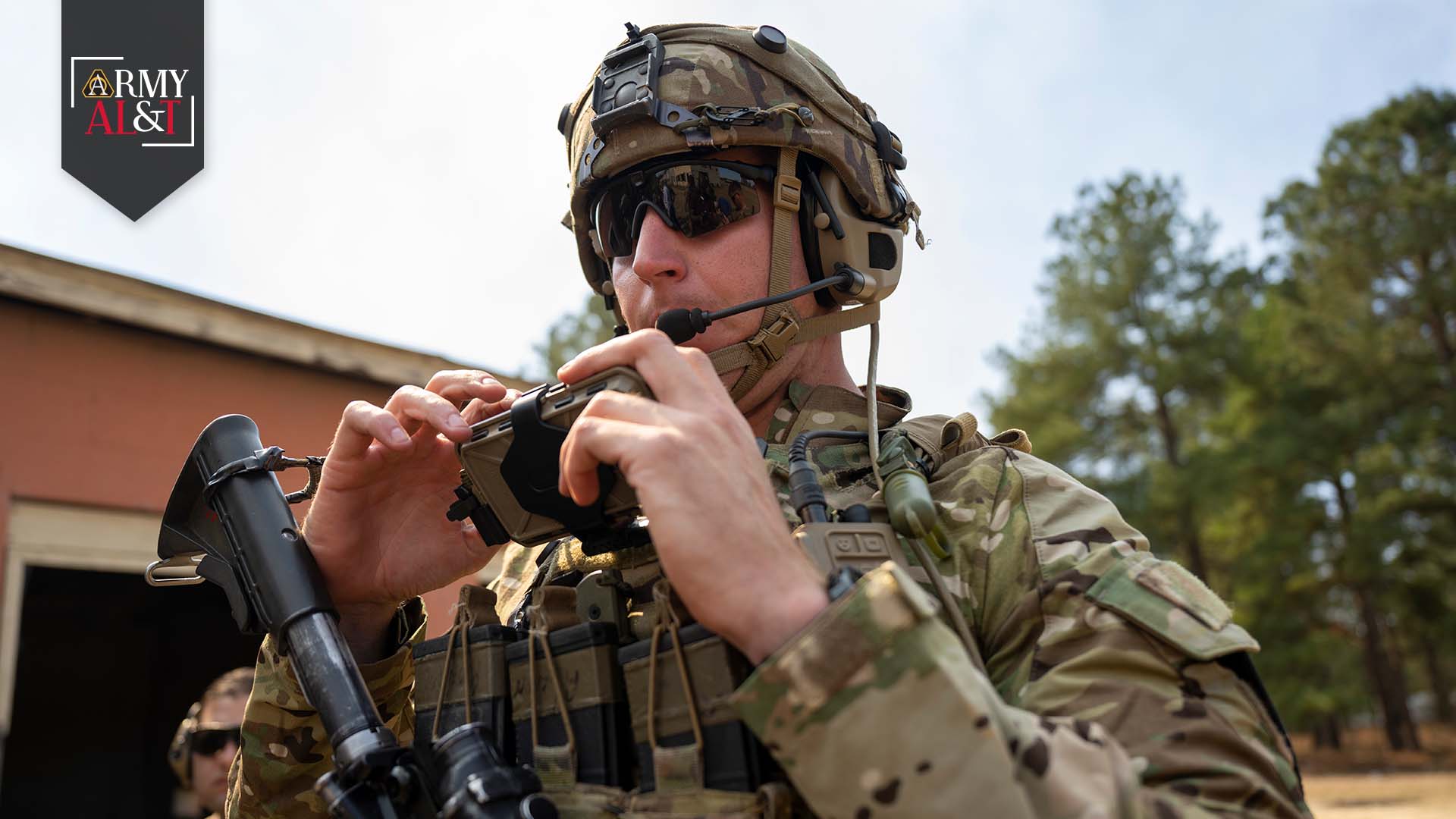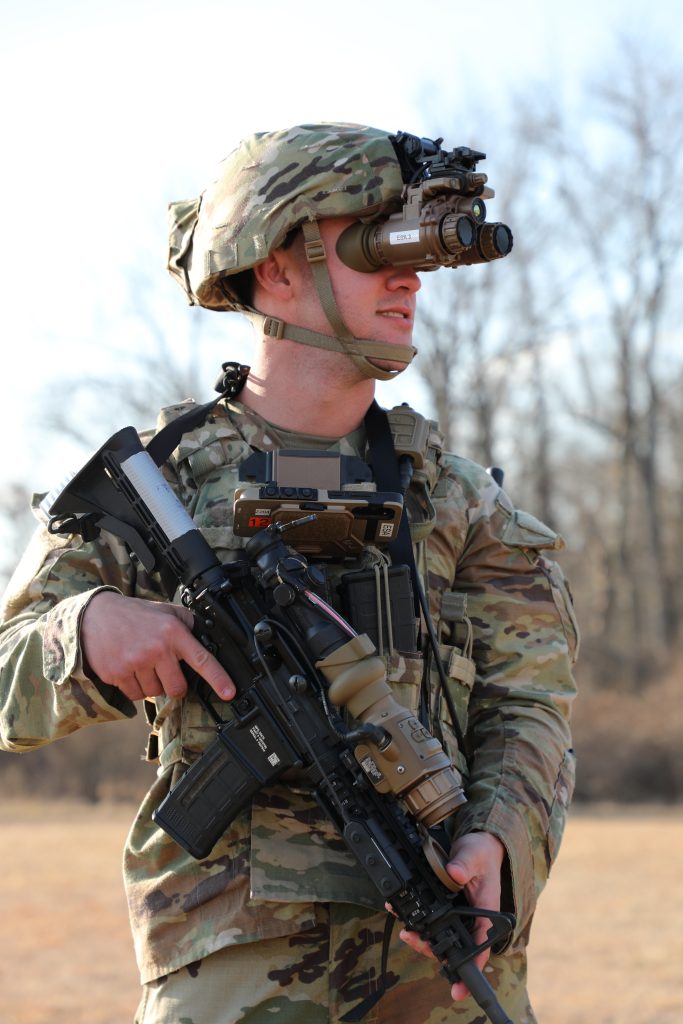
SPOT CHECK: A Soldier checks his Nett Warrior during an Army Expeditionary Warrior Experiment force-on-force field demonstration held on Fort Benning, Georgia on March 4, 2022. Nett Warrior uses smartphones with tactical applications networked through radios to provide better situational awareness to Soldiers. (Photo by Jason Amadi)
When used together, Nett Warrior and the ENVG-B’s common operating picture provide Soldiers overmatch against adversaries.
by Frederick Shear and Jason Amadi
Nett Warrior and the Enhanced Night Vision Goggle-Binocular (ENVG-B) are examples of evolving programs that integrate new capabilities in existing platforms rapidly.
Nett Warrior leverages commercial smartphones with tactical applications networked through radios to provide Soldiers greater situational awareness. It allows for fast, accurate decisions in tactical engagements. Deployed to Iraq and Afghanistan over the last decade, the system can map and display on a smartphone the location of friendly and enemy forces, targets and terrain points.
Mounted on a Soldier’s chest, connected to their Improved Outer Tactical Vest or Modular Scalable Vest, this situational awareness system consists of a smartphone end user device, Android Tactical Assault Kit (ATAK) software, chest mount and radio.
UPGRADES UPGRADED
Nett Warrior developed out of the Land Warrior program, as the Army sought to provide dismounted Soldiers a fuller picture and real-time understanding of their surroundings while donning less cumbersome equipment. Since 2012, the Army has fielded six versions of Nett Warrior and more than 23,000 systems. The ability to take Soldier feedback and quickly incorporate it into a more advanced system has been a hallmark of the program since its inception.
The Army started delivering the most current Nett Warrior in July 2021. This version features a Samsung S20 as the phone (an upgrade from the S7 used previously), a Dock-Lite mounting system and wireless network connections that eliminate the need for bulky cables to connect to a radio.
The Army has provided 3,800 systems to the combat force to date and will deliver 8,200 to units over the next several months.

RAPID RELAY: Strong partnerships among organizations allows the rapid incorporation of Soldier feedback for Nett Warrior upgrades. (Photo by Justin Sweet)
SOLDIER-CENTERED DEVELOPMENT
Lt. Col. Denny Dresch, the product manager for Ground Soldier Systems, noted how the Nett Warrior features a modified commercial-off-the-shelf device, which allows the Army to quickly find and procure solutions to meet Soldier needs.
Strong partnerships among several Army organizations foster an environment that allows for the rapid incorporation of feedback and acquisition and delivery of Nett Warrior upgrades.
“When we get Soldier feedback, whether from a Soldier touch point or operational assessment, we take our lessons learned and begin to iterate for system-of-systems improvement using a test-fix-test methodology,” said Dresch. The product manager shop, Dresch continued, conducts such events at several venues, including the Soldier Integration Facility at Fort Belvoir, Virginia, the C5ISR Center at Aberdeen Proving Ground, Maryland, and the Electronic Proving Grounds at Fort Huachuca, Arizona.
The Program Executive Office (PEO) for Soldier also works closely with PEO for Command Control Communications – Tactical (C3T) and its project manager for tactical radios to maintain interoperability standards on Nett Warrior systems.
COLLABORATION FOR FUNCTIONALITY
Nett Warrior’s capabilities have expanded through its synchronization with the Army’s Integrated Tactical Network (ITN). The ITN is an approach that introduces innovative commercial components and network transport capabilities into the tactical network environment. By inserting commercial capabilities, Soldiers are operating a simplified, independent network solution that is modern and provides enhanced, flexible network availability at the brigade level and below.
The ITN’s commercial components include several varieties of software-defined tactical radios, including both single channel radios and two-channel leader radios, tethered drones, small satellite terminals and commercial phone technology. The ITN’s radios communicate using the Tactical Scalable Mobile Ad-hoc Network (TSM) waveform, which forms a mesh network the Army calls a communications “bubble” for all the formations that need to communicate. Using TSM in conjunction with tethered drones, which consists of a drone with a single channel radio affixed to it that when raised above the tree line, provides an extended network of up to 20 kilometers.
By integrating Nett Warrior with the ITN radios, commanders achieve a consolidated air, ground and fires picture into a single common operating picture.
During several exercises from 2021–2022, paratroopers with the 1st Brigade Combat Team, 82nd Airborne Division at Fort Bragg, North Carolina, have used their ITN radios and Nett Warrior devices to provide their commanders with position location. Commanders have reported immediate 90 percent accountability before exiting the drop zone to execute their mission.
One key change the ITN brings to the Army’s tactical network is the ability to operate over the secure-but-unclassified security enclave, which allows Nett Warrior to use a mixture of military and commercially available networks. By adding secure-but-unclassified enclave to the Army’s commercial national security algorithm, Soldiers using Nett Warrior are no longer restricted to communications across a single-path transport. Multiple pathway options allow the generation of a more robust primary, alternate, contingency and emergency plan when Soldiers encounter contested or congested environments. The secure-but-unclassified enclave also allows data to be categorized in accordance with its classification. Because the majority of tactical information below the battalion level is time-sensitive, perishable and unclassified, such as position information location during mobile missions, the secret network is not necessarily optimal in all operating conditions.

BETTER TOGETHER: Soldiers can receive and display augmented reality, targeting and situational graphics on the ENVG-B when it interfaces with Nett Warrior. (Photo by Courtney E. Bacon)
MID-TIER MAKES GOOD
In late 2018, to rapidly field commercial network capability to priority units, the Army, through PEO C3T and PEO Soldier, formed a team of acquisition professionals to develop an acquisition strategy, procurement and test plans and production strategy for the ITN effort. The Army acquisition executive (AAE) designated the project manager tactical radios as the office of primary responsibility.
The AAE then granted the project manager radios team with middle-tier acquisition authority for both prototype and fielding, ultimately assuring ITN fielding within five years of its approved requirement. The plans that led to mid-tier acquisition are now an example across the Army. In less than two years, the team took ITN from concept to reality, and procured capability for fielding in the 2021 fiscal year.
The mid-tier pathway “enabled [the tactical radios program office] to rapidly prototype commercial technologies using an abbreviated requirement document and gain Soldier feedback to continually enhance the capabilities and inform Army design and fielding decisions,” said Jerry Harper, the product manager for Helicopter and Multimission Radios, under PEO C3T.
RAPID ACQUISITION
Nett Warrior interfaces with the ENVG-B to allow the Soldier to receive and display augmented reality navigational, targeting and situational graphics on the ENVG-B. The augmented reality technology delivers heads-up situational awareness in the ENVG-B for tactical and training situations when used with Nett Warrior. Rather than looking down at a 2D map or smartphone device, the Soldier sees virtual icons overlaid on their real-world view in real time. Navigation, known friendly and enemy locations, targets, and orientation in a given area, are all broadcasted directly to a Soldier’s field of view.
The ENVG-B is a helmet-mounted individual night-vision device with an integrated long-wave infrared thermal sensor and high figure-of-merit white phosphorus, dual image-intensification tubes. A fused thermal and image intensification image is displayed in high definition. The infrared sensor detects heat and can be used during low- and high-light levels, extreme weather and with obscurants. The ENVG-B is interoperable with the Family of Weapon Sights-Individual for rapid target acquisition that provides the Soldier the ability to accurately engage targets without shouldering the weapon.
The ENVG-B program began in December 2017 with the approval of a directed requirement to deliver this critical capability to Soldiers. Leveraging an urgent-capability acquisition strategy, the first ENVG-B systems were fielded to Soldiers of the 2nd Brigade, 1st Infantry Division in September 2019.
“Our team worked closely with our partners at the Soldier Lethality Cross-Functional Team to expedite the staffing of the directed requirement and Army Contracting Command-Aberdeen Proving Ground [ACC-APG] to develop a contracting strategy to support the rapid procurement of the ENVG-B,” said Lt. Col. Melissa Johnson, the product manager for Soldier maneuver sensors. “Without the exceptional support of both of those teams, we wouldn’t have achieved the critical milestone of placing the first ENVG-B system into the hands of Soldiers in such a short period,” said Johnson.
PRODUCTS EXPEDITED
PEO Soldier’s partnership with the ENVG-B’s primary contractors, L3 Harris and Elbit Systems America, was another one of the key aspects of expediting the program timeline. With their help and flexibility through the pandemic, PEO Soldier met major production and delivery milestones.
Working to deliver the same system, L3 Harris and Elbit Systems America resourced production lines to maximize efficiency and remained flexible to the many challenges presented during the pandemic. For the ENVG-B directed requirement, L3 Harris delivered the 10,000th ENVG-B this past April and Elbit delivered ENVG-B systems to support continued production qualification testing. These were significant achievements by the team and were directly influenced by the level of effective and consistent communication across all teams.
Similar to L3 Harris and Elbit, the entire PEO Soldier team faced challenges during the pandemic and had to rely on the dedication of its staff to meet various challenges in delivering the ENVG-B. Even through the pandemic, Soldier Lethality Cross-Functional Team and PEO Soldier conducted 16 Soldier touch points throughout ENVG-B development to inform the final design of the system and ensure user acceptance. To date, the ENVG-B program has fielded more than 9,000 ENVG-B systems to eight brigade combat teams across the Army.
“All teams face challenges, but I think how we react to those challenges is what really makes a team proficient. We faced limitations early in terms of travel and the maximum telework policy, however, we were able to work with the primary contractors to develop innovative techniques to achieve deliveries,” Johnson said.
“One example was the virtual product acceptance, where our team and the in-plant Defense Contract Management Agency quality assurance representative inspected systems virtually to support shipment and subsequent fielding’s of the ENVG-B systems.
Our team at PEO Soldier did an exceptional amount of work. They showed sheer dedication, patience and perseverance. They’re true professionals. They moved forward through that period of uncertainty with pride and a great attitude. You couldn’t ask for a better team of professionals,” Johnson added.
CONCLUSION
Individually, Nett Warrior, the Integrated Tactical Network, and ENVG-B are great capabilities. However, when used together, they provide unmatched situational awareness capability to our combat formations that improves mission planning, communication and decision-making at the Soldier and squad level. The common operating picture delivered by this system of systems provides our Soldiers overmatch against peer and near peer adversaries. These enhanced capabilities are invaluable in any current or future operational environment.
For more information, go to https://www.peosoldier.army.mil.
FREDERICK SHEAR is a communications specialist providing PEO Soldier Project Manager Integrated Visual Augmentation System (PM IVAS) public affairs support on behalf of TMGL LLC. He also serves as a major in the U.S. Army Reserve.
JASON AMADI is a communications specialist providing PEO Soldier PM IVAS public affairs support on behalf of JANSON Communications.







